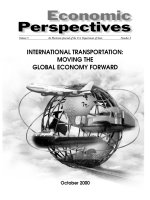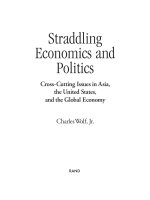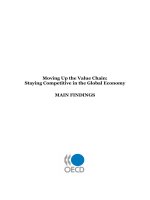makansi - lights out; the electricity crisis, the global economy, and what it means to you (2007)
Bạn đang xem bản rút gọn của tài liệu. Xem và tải ngay bản đầy đủ của tài liệu tại đây (3.82 MB, 321 trang )
P1: OTE/PGN P2: OTE
JWPR013-Makansi May 4, 2007 23:6
Lights Out
The Electricity Crisis,
the Global Economy, and
What It Means to You
Jason Makansi
John Wiley & Sons, Inc.
i
P1: OTE/PGN P2: OTE
JWPR013-Makansi May 4, 2007 23:6
Copyright
C
2007 by Jason Makansi. All rights reserved.
Published by John Wiley & Sons, Inc., Hoboken, New Jersey.
Published simultaneously in Canada.
Wiley Bicentennial Logo: Richard J. Pacifico.
No part of this publication may be reproduced, stored in a retrieval system, or transmitted
in any form or by any means, electronic, mechanical, photocopying, recording, scanning,
or otherwise, except as permitted under Section 107 or 108 of the 1976 United States
Copyright Act, without either the prior written permission of the Publisher, or
authorization through payment of the appropriate per-copy fee to the Copyright
Clearance Center, Inc., 222 Rosewood Drive, Danvers, MA 01923, (978) 750–8400, fax
(978) 646–8600, or on the Web at www.copyright.com. Requests to the Publisher for
permission should be addressed to the Permissions Department, John Wiley & Sons, Inc.,
111 River Street, Hoboken, NJ 07030, (201) 748–6011, fax (201) 748–6008, or online at
www.wiley.com/go/permissions.
Limit of Liability/Disclaimer of Warranty: While the publisher and author have used their
best efforts in preparing this book, they make no representations or warranties with respect
to the accuracy or completeness of the contents of this book and specifically disclaim any
implied warranties of merchantability or fitness for a particular purpose. No warranty may
be created or extended by sales representatives or written sales materials. The advice and
strategies contained herein may not be suitable for your situation. You should consult with
a professional where appropriate. Neither the publisher nor author shall be liable for any
loss of profit or any other commercial damages, including but not limited to special,
incidental, consequential, or other damages.
For general information on our other products and services or for technical support, please
contact our Customer Care Department within the United States at (800) 762–2974,
outside the United States at (317) 572–3993 or fax (317) 572–4002.
Wiley also publishes its books in a variety of electronic formats. Some content that appears
in print may not be available in electronic formats. For more information about Wiley
products, visit our Web site at www.wiley.com.
Library of Congress Cataloging-in-Publication Data:
Makansi, Jason.
Lights out : the electricity crisis, the global economy, and what it means to you / Jason
Makansi.
p. cm.
Includes bibliographical references and index.
ISBN 978-0-470-10918-2 (cloth)
1. Electric utilities–United States. I. Title.
HD9685.U5M326 2007
333.793
20973–dc22 2007008125
Printed in the United States of America
10987654321
ii
P1: OTE/PGN P2: OTE
JWPR013-Makansi May 4, 2007 23:6
This book is dedicated to Munzer and Nellie Makansi, my dad and
my mom, who both seem to get younger with each passing year.
iii
P1: OTE/PGN P2: OTE
JWPR013-Makansi May 4, 2007 23:6
iv
P1: OTE/PGN P2: OTE
JWPR013-Makansi May 4, 2007 23:6
Contents
Preface vii
Acknowledgments xiii
Part One The Worst-Case Scenario 1
Chapter 1 Night of the Living Dead 3
Chapter 2 The Production and Delivery Value Chain 19
Chapter 3 Around the World, Around Town 37
Chapter 4 Preventing the Worst Case 59
Part Two Insecurities, Vulnerabilities, and an
Uneasy State of the Industry 73
Chapter 5 Why a First-World Country Has a Third-World
Grid 77
Chapter 6 Living with a Transaction Economy 91
Chapter 7 The Brain Drain 99
Chapter 8 Environmental Imperatives 111
v
P1: OTE/PGN P2: OTE
JWPR013-Makansi May 4, 2007 23:6
vi CONTENTS
Chapter 9 Houston, We Have a Problem 123
Chapter 10 The Impact of Lengthening Supply Lines: How
Elastic Are They? 131
Part Three Fighting “the Last War,” Planning the
Next One 143
Chapter 11 It’s That ’70s Show 145
Chapter 12 Sticker Shock (Without the Sticker) 155
Chapter 13 Electricity Storage 163
Chapter 14 Coal: Extracting Its Full Value 173
Chapter 15 Exercising the Nuclear Option 187
Chapter 16 Savvy Consumption, Empowering Ratepayers 207
Chapter 17 Distributed Power 221
Chapter 18 Redefining the Grid with Real Intelligence 233
Chapter 19 The Rest of the World 241
Chapter 20 A Vision for the Future: Daydream, Nightmare,
or a Good Night’s Rest? 257
Postscript: Personal Accountability 275
Bibliography 283
About the Author 291
Index 293
P1: OTE/PGN P2: OTE
JWPR013-Makansi May 4, 2007 23:6
Preface
T
he day I started writing this book was the day the lights went
back on in our house after a very hot and humid four-day
electricity outage. It was late July in St. Louis when the storm
literally blew down our street, toppling hundred-year-old trees and, with
them, hundreds of power lines. We were among the lucky ones. We
suffered minimal storm damage and a loss of power that was, in some
cases, almost a week less than some of our neighbors. Fast forward six
months to early December. As I complete the first comprehensive draft
of the book, 500,000 customers are still without electricity following a
brutal winter storm that swept across the region. I can’t image a more
appropriate (or unfortunate) way to book-end a manuscript called Lights
Out.
Two difficult outages in one year and the accusations are flying.
Investigations have been initiated. And St. Louis is not alone. Major
electricity outages have hit metropolitan areas such as Chicago, Detroit,
Seattle, and New York. The same is true for entire geographic regions
such as the blackout of 2003 in the northeastern United States and parts
of Canada, the 2006 blackout that affected many cities across Europe, and
those outages that are common occurrences throughout the developing
vii
P1: OTE/PGN P2: OTE
JWPR013-Makansi May 4, 2007 23:6
viii PREFACE
world. This demonstrable increase in what utilitiescall “reliability events”
began in the mid-1990s. What is causing this string of outages, the effects
of which range from catastrophic to inconvenient, is one key issue that
I address in this book.
My friends and neighbors have a simpler question: Who’s to blame?
How could such a serious outage happen twice in one year? I don’t want
to remind them that another serious one occurred last summer, although
it did affect different parts of the city. The root cause of most, if not all,
widespread service interruptions is a combination of extreme weather
events and deficient utility operations and equipment and work processes
that lead to malfunctions. Mother Nature and Father Utility conspire to
ruin your day, or week, as the case may be.
That’s the simple version—the version easiest to see and understand.
However, as with most things, the reality is much more complicated. It
is often hard to determine where Mother Nature ends and Father Utility
begins. In most areas of the United States, dear old dad isn’t acting alone
but is instead working at the direction or under the oversight of the reg-
ulator, or state public utility commission (PUC). Electric utility service
comes courtesy of a two-headed beast—the utility service provider and
the state regulator.
Less reliable service is not the only big issue looming over electric-
ity delivery, just the one with the greatest direct impact on our lives.
Electricity production is the second largest influence on global climate
change. Automobiles are the largest. Our electricity service is expected
to become more dependent on global energy supply lines that feel less
and less secure as the government fights its War on Terror. The business
of electricity service has shifted from one driven by engineers to one
driven by financial engineering. All of these issues are intricately woven
together. The resulting tapestry reveals an industry in peril and electricity
consumers mostly ignorant of the dangers that lie ahead.
I want to accomplish three primary objectives with this book. One
of the most important is to explain how we’ve arrived at our current
predicament, and why it is vastly different from state to state as a result of
some dubious deregulation and competition programs launched in the
late 1990s. (A note to all of the free-marketers out there: I’m not against
competition. Far from it. I am saying—and most other experts are saying
P1: OTE/PGN P2: OTE
JWPR013-Makansi May 4, 2007 23:6
Preface ix
it, too—that the seeds of deregulation’s failure were contained in the way
the programs were conceived.)
But the past isn’t as important as the future. The second objective I
have for the book is to lay out the electricity roadmap before you—one
I believe will take us to a better place. It is obvious that we’re not now
headed anywhere that we want to go. In fact, electricity’s present map is
not a pretty map at all. The road we’re on is all too familiar, and where
we’re headed is pretty much like where we’ve already been—only more
so. Let me assure you. We don’t want to stay on this course. We need
something different, hopefully something better. In the last section, I
propose a strategy that charts what I believe is a much better course.
My third objective is to galvanize you to action. I hope that this book
motivates you to speak up, to take the small steps that we can all embrace
in order to build momentum and drive our electricity-driven society
toward change. It comes down to this: It is up to us to ensure that our
neighborhoods, our cities and states, our nation, and the economy that
drives it do not deteriorate because we no longer have the most robust
and reliable electricity system in the world.
This book follows my book An Investor’s Guide to the Electricity Econ-
omy (Hoboken, NJ: John Wiley & Sons, 2002). After An Investor’s Guide
hit the shelves, I decided to put my money where my mouth was. I
started an investment fund. My partners and I worked to monetize the
information in the book by focusing specifically on the electricity pro-
duction and delivery value chain. Since then we’ve experienced real
change in society, in the business world, and in the electricity sector
specifically. Electricity is the largest business sector in the country, with
larger-than-life characters and wild mood swings. Just before I finished
the first book, Enron imploded, and the rest of the electricity industry
tumbled down after it; the effects of 9/11 were still taking shape; and the
“new millennium” for the energy industry could not have gotten off to
a more inauspicious start.
As I put the finishing touches on this book, the Republican ma-
jority has been swept out of Congress, the Bush administration is under
relentless attack over the Iraq war, and the U.S. electricity business has
almost completely retreated from the globalization that characterized the
1990s. China and India have ascendant economies, becoming an increas-
ing consumer of the world’s commodities, many of which we consume
P1: OTE/PGN P2: OTE
JWPR013-Makansi May 4, 2007 23:6
x PREFACE
in great abundance for our electricity needs. Electricity service disrup-
tions seem to be rampant. A million customers were without power in
the Seattle area following a severe windstorm in December. This power
disruption marked the first time since 1953 that the Seattle Times was
unable to publish, and only the third time in the paper’s history that it
wasn’t able to put out a paper. As you will see, everything—from local
publishers to national elections to distant economies and global weather
systems—is inextricably related. As this book unfolds, I’ll attempt to
connect the dots for you.
One thing has not changed in these past five years. As a nation, we do
not pay enough attention to our electricity service. It is something that
is missed only by its absence, as in when your service is disrupted. We
do not fully realize the breadth of impact of our electricity production
and consumption—we are 3 percent of the world’s population and we
produce and consume 25 percent of the world’s electricity. We do not see
that the supply lines for virtually everything needed for our electricity
infrastructure are expanding across the globe. When we think of elec-
tricity at all, it is only in terms of our local electric utility, not in terms of
the diverse energy sources needed to generate it, the long transmission
lines needed to move it, the vast network needed to distribute it, and
the emissions and discharges that result from the entire process.
I wrote this book to call attention to these other, less savory aspects,
of electricity. I am a consultant to the industry, and electricity has been
my career. I see our industry backsliding, rather than moving forward. I
see our leadership in the technology, once unchallenged, now seriously
eroded. I see our industry leaders neglect the least valuable and most
nettlesome component of the value chain, our transmission system. It
is only 10 percent of the “value chain,” but it is the linchpin between
supply and demand. Transmission experts describe it as a “third-world
grid.”
I believe we’re headed for real trouble in that part of our economy,
the electricity infrastructure, which supports and enables the rest of it.
Power delivery is at the heart of our modern, increasingly digital society,
and electricity is its life blood. When disaster strikes, it is the electricity
system that must recover first and fastest because it powers every other
layer of infrastructure—fuel delivery, water systems, telecommunications,
P1: OTE/PGN P2: OTE
JWPR013-Makansi May 4, 2007 23:6
Preface xi
mass transportation, banking, and health care. In the modern world,
electricity is not optional.
Our industry’s leaders think we’re back to the good times. We’re
embarking on a massive power plant construction program. Private in-
vestment funds are pouring into our industry. The economy has done
well over the last four years. You can hear the charge: “More is bet-
ter!” I’m going to throw some metaphorical cold water on these people,
hopefully to jolt them out of their stupor. In this pursuit, you may also
get “splashed.” If we’re going maintain our economy—let alone grow
it—then each of us has to acknowledge our own role in the electricity
production and delivery value chain, that of responsible consumer.
P1: OTE/PGN P2: OTE
JWPR013-Makansi May 4, 2007 23:6
xii
P1: OTE/PGN P2: OTE
JWPR013-Makansi May 4, 2007 23:6
Acknowledgments
I
am grateful to my wife, Kristina, who plays such a key role in making
my prose less dense and more approachable for those readers outside
the electricity business—and for helping this graphically challenged
author with illustrations. Also, I wish to thank Robert Schwieger, the
editor, publisher, and chief bottle-washer and cook for Combined Cycle
Journal. He had been my boss (“captain”) for 18 years at Power and
Electric Power International magazines and the myriad publications and in-
dustry events that we launched together. He is also a career-long mentor
and friend. Bob read and commented on the draft manuscript when he
had far better things to do over Christmas. Bob essentially gave me the
opportunity to build the career that I enjoy today.
Finally, it is important for all of us to acknowledge the men and
women who actually work on, in, and around the electricity infrastruc-
ture. They are the ones who keep the lights on; our entire society benefits
from their hard work, often under adverse circumstances.
xiii
P1: OTE/PGN P2: OTE
JWPR013-Makansi May 4, 2007 23:6
xiv
JWPR013-Makansi April 30, 2007 14:13
Part One
THE WORST-CASE
SCENARIO
L
iving without electricity is visceral, maybe even surreal. You
begin to feel the difference in everything you do, in almost every
step you take. In a very real sense, the lack of electricity drains the
lifeblood out of you. You certainly begin to feel a loss of control, and for
good reason. The vast majority of us are not in control of our electricity
service. It’s bad enough to recount your movements in an electricity-less
world. Most of us have been through a recent and lengthy outage. It feels
like the worst-case scenario. But when you envision a future influenced
by the issues that I mentioned in the preface, you begin to realize that
the worst case in the years ahead could be worse.
In this section, we walk through what happens in an outage so that
you can experience how electricity pervades modern existence. Then we
learn how today’s system works, from the extraction of the raw energy
source to the electricity-consuming appliances in your home. After
1
JWPR013-Makansi April 30, 2007 14:13
2 theworst-casescenario
that, we experience more than a century of colorful industry history
condensed into what I hope is an engaging and fun approach. Finally,
we return to the worst-case scenario theme and show how a system that
is breaking can be fixed.
JWPR013-Makansi April 30, 2007 14:13
Chapter 1
Night of the Living Dead
Y
ou are into day three without electricity at your residence.
The heat wave is scorching and you have no air-conditioning.
Friends up the street who really can’t stand the heat booked
what they claim was one of the last rooms available at a hotel still con-
nected to the grid. All the food in the refrigerator is fast becoming fodder
for the dumpster. The security system has exhausted its last electrons of
backup battery power.
The line last night at the only Mickey D’s still able to serve up
burgers was brutal. The land-line phones in the house have been down
since the storm blew through because they are all remotes that require
an electrical connection. You’ve resorted to burning gasoline in your
car to keep the cell phone charged up and your body cool, but you are
wondering if you can refill the automobile’s tank because half the local
stations can’t run their pumps. You’re taking quick showers, careful to
use as little hot water as possible, knowing that the water heater’s controls
are also electronic and don’t work without power.
3
JWPR013-Makansi April 30, 2007 14:13
4 theworst-casescenario
In the initial hours of the outage, you learned to live without Inter-
net and cable television. These aren’t essentials, you think to yourself,
although your kids have a different opinion and have spent most of
the day moving from one Wi-Fi hotspot to another. Meanwhile, more
gasoline is consumed.
You go upstairs to use the bathroom and discover that the water tank
on the toilet isn’t filling back up. That’s weird. The cold water supply
to the sink and the bathtub are also low. Check with the neighbors.
Same issue. Is there a connection to the electrical outage? Perhaps. The
city water system may have lost one or more of the pumps that keep
the water pressure high enough to reach the upper floors of homes. Or
the water flows had to be redirected because of pump outages, a water
main broke from being overloaded, and less water is now in the system.
Indeed, in the morning you read that a water main broke less than a
mile from your home.
Many of the neighbors have fled to relatives or friends who live in
outlying areas. They’ve been told of the news reports presaging no relief
from the heat wave. On the first night or two, there was some comfort,
even gaiety, as neighbors gathered on front porches to share storm stories
while curious others walked by with their dogs and kids. You were busy
keeping chins up in the face of adversity and just thankful that no one
in the neighborhood was hurt. Now, it’s the third night without power.
The neighborhood is eerily quiet. No lights, no security systems. The
city’s a mess, with thousands of trees down. Police, firefighters and even
the National Guard are working to locate individuals who may be at
risk of heat stroke. You live in a historic city neighborhood where gang-
related petty crime is always an issue, but now everyone’s talking about
looting. How long before the frustration turns to anger, anger turns
to opportunity, and gangs of marauding youth begin plundering the
homes?
At the office the next day, power is available. The high-rise office
building has a backup generating system in the basement and is con-
nected to the grid in such a way that it can get electricity from more
than one source. You do some Internet research on your local util-
ity or electricity service provider. You find that the utility’s customer
satisfaction indices have slipped this year compared to last. You also dis-
cover that there have been controversies between the utility and the
JWPR013-Makansi April 30, 2007 14:13
Night of the Living Dead 5
Public Service Commission (PSC), which regulates the utility, about
expenditures for distribution system improvements. Not sure how all
this relates to your particular situation, you push it to the back of your
mind.
You leave work early. Even though the air-conditioning works fine
at the office, the last time you slept without air-conditioning on such
hot evenings was when you first got out of college and had no money.
You can barely type or write in between yawns.
At 3:30 in the morning of day four, you wake to the blaring siren of
your security alarm. The power’s on—at least on your side of the street.
Lights all over the house are on, ceiling fans are whirring, the siren is
still screaming and you are completely disoriented. The whole scene is
jarring. But the lights are on! Once daylight breaks a few hours later,
you move on to the tasks of cleaning up and throwing out. Things begin
to return to normal, although it will be another four days of darkness
for your friends right across the street.
But for now, it’s over. That’s it. The worst-case scenario is behind
you, isn’t it? You wish.
Lurking in the Shadows
Most of us don’t think about electricity at all unless it isn’t there. But
your service, whether at home or at your business, is merely the last link
in a long electricity production and delivery “value chain” that is getting
longer, going global, governed by vacillating regulations, and subject to
all sorts of new threats and vulnerabilities.
Your electricity comes through a distribution circuit, connected
to other distribution circuits, which are fed by the transmission system
(those long high-voltage wires that go off into the horizon), which is fed
by the power plant, which gets its energy from either water in the form of
a hydroelectric dam, wind, coal, natural gas or uranium, which can come
from places as close as America’s heartland or as distant as Iran, Nigeria,
Russia, Australia, Venezuela, or Kazakhstan. The large power stations
that generate electricity serve various classes of customers: industrial,
commercial, and residential. After electricity is first generated, it is greatly
increased in voltage to make the long trek over the transmission line more
JWPR013-Makansi April 30, 2007 14:13
6 theworst-casescenario
efficient, and then stepped down in voltage as it is taken off the grid for
delivery to an end user.
Coal, uranium, and natural gas account for more than 90 percent
of the electricity generated in the United States. Renewables make
up the rest—with hydroelectric at around 8 percent, wind at 1 per-
cent, and a variety of other sources making up the rest. Today, most of
this raw energy is sourced in North America. However, over the next
20 years, things are likely to be different. I like to portray the production
and delivery value chain as a “supply line.” Unlike in the past, your elec-
tricity doesn’t really come from a nearby utility. It can come from hun-
dreds, or even thousands, of miles away. These supply lines can be fragile.
Twenty years ago, a worst-case scenario blackout was a much simpler
event because the supply line was tighter. A vertically integrated electric
utility, highly regulated, was responsible for the entire electricity supply
and delivery chain of events. In many cases, these electric utilities also
had some control over the coal, natural gas, and nuclear fuel used in
their power stations.
In the 1980s, the nation began a protracted experiment with dereg-
ulation of the electricity industry. Deregulation was a social, political,
and economic trend that affected trucking, telephones, airlines, banking,
natural gas, and health care. In the 1990s, under the banner of global-
ization, large swaths of the rest of the world also began to dismantle
state-owned energy enterprises, such as electric utilities, and began to
create market-oriented businesses.
Today, and for the last five years, the electricity industry is in what I’ve
called in my speeches to the industry a “quasi-deregulatory quagmire.”
Depending on where you live, and how vigorously your state pursued
competition and deregulation, the vertically integrated supply chain has
been busted apart. Some states imposed no competition in the first
place. Some started down the path but reverted to regulation. Other
states went so far down the competition path that no amount of political
maneuvering can “put the genie back in the bottle.” In many other
countries, deregulation proved to be little more than political rhetoric
or window-dressing.
The triple forces of deregulation, market-oriented institutions, and
globalization have resulted in many of the consequences that will be
described later in this book. However, one of the most important is that
the transmission function in this country somehow got lost and ignored
JWPR013-Makansi April 30, 2007 14:13
Night of the Living Dead 7
during most of the deregulatory fervor. As a result, this country now has
what many transmission experts call a “third-world” grid. It’s a clever
sound bite, but most people will understand the phrase. Certainly, after
two major outages this year, my friends and neighbors get it loud and
clear.
We have to be careful about how we use the word grid. Some industry
experts use it to refer only to the transmission function. To others, the
grid means all the lines, wires, and circuits between the power station and
the electricity meter attached to your home. In other words, it includes
the transmission and the distribution functions. In this book, we use it to
refer to the latter—all transmission and distribution functionality—and
use the phrase transmission grid to mean only the transmission assets.
Thirty years ago, we in the industry described our transmission grid
system as “gold plated.” That means that utilities usually spent more
than they needed to ensure that the system was robust and probabilities
of massive failures were as close to zero as possible. The reliability of
your service used to be something akin to a social guarantee. Regulators
benchmarked, or compared, their utilities to others, based on reliability.
Today, utilities are trying to maintain some semblance of reliable service
on the backs of a deteriorating transmission grid and in the face of a
more competitive world for electricity supply.
Many of the much-vaunted positive benefits of deregulation, like
lower electricity prices, more reliable service, and new consumer and
demand-management technologies, could only have occurred with im-
provements, constant upkeep and greater integration of the transmis-
sion system. Ironically, just the opposite has occurred. Transmission
has become the weak link in the supply chain, and many of those
positive benefits have yet to materialize. All those ultra-modern, next-
generation services deregulation was going to bring to your front door
were, unfortunately, dependent upon an increasingly “brittle” transmis-
sion grid. Imagine driving a brand-new Maserati over a road littered with
potholes.
We’re supposed to be balancing electricity supply with electricity
demand nationwide, or at least regionally through competition. Low-
cost power in the Midwest is being shipped to New England where
costs are typically higher. Areas with great reserves of coal, prime sites
for new coal-fired units, could generate power economically, and it
could be shipped to high-cost regions.
JWPR013-Makansi April 30, 2007 14:13
8 theworst-casescenario
However, because the transmission grid got lost in the deregulatory
shuffle, the ability to move this power around to meet these market-
oriented expectations did not expand. And, because the utilities and
regulators were focused on other parts of the system, the basic infras-
tructure was actually allowed to deteriorate.
Are you one of those people who would like to see coal-fired gen-
erating plants shut down, replaced with renewable energy? One reason
you won’t see this happen in a big way is that the country lacks the
transmission infrastructure to bring wind energy from high-wind areas
(usually where few people live) to the places where electricity demand
is highest (such as big cities).
So the number one vulnerability in our electricity system is a deteri-
orating transmission grid. While the government and industry have studied
the problem and have been taking steps to fix this, progress is slow, and
too few of the industry’s resources are focused on it.
At the Heart of It All
When you are in the middle of an electricity outage, it’s easy to un-
derstand how interconnected is our infrastructure. Phones don’t work,
trains don’t run, elevators stop between floors, water pumps quit pump-
ing, compressors that move fuel like natural gas stop turning, computers
no long whir, and so on (see Figure 1.1). Electricity is to modern society
like blood that runs through the body. It touches everything. It powers
everything in some way. If you viewed our infrastructure as a pyramid,
electricity would be the base, the bedrock, the foundation upon which
everything else depends.
To understand the predicament we may find ourselves in a decade
or two from now, imagine inverting that pyramid to where everything
from the base down is dependent on the unstable apex.
Fear at the Heart of the Future
Once you thoroughly survey the entire supply chain, transmission isn’t
the only weak link. When was the last time you thought long and hard
JWPR013-Makansi April 30, 2007 14:13
Night of the Living Dead 9
New
Technology
Development
Transportation
Airports
Railways
Information
Technology
Telecom
Banking
Investments
Petroleum
Natural
Gas Supply
Water Supply
Sewage
Treatment
National
Security
Electricity*
Figure 1.1 Electricity is fundamental and central to modern life.
Note: There is no Strategic Electricity Reserve as there is for oil upon
which to draw in case of a true national emergency.
about freight trains? Many Americans believe that our era of dependence
upon the railroads ended long ago. But today, more than 50 percent of
our electricity comes from the conversion of coal at power stations, and
much of that coal is shipped over long distances by rail—from Wyoming
to Georgia, for example. Electric utilities east of the Mississippi have
been complaining about poor rail service, and are therefore having a
difficult time maintaining coal inventories.
Several decades ago, these fuel supply lines were shorter. There
are two reasons why coal is hauled greater distances today. Coal from
the western United States, primarily the Powder River Basin (PRB)
in Wyoming and parts of Utah, is cheaper and has less sulfur than
coal from traditional eastern sources concentrated in Kentucky, West
Virginia, Illinois, and Ohio. The tradeoff is, however, that it is also a
poorer quality coal that burns less efficiently and increases the discharge
of carbon dioxide and other pollutants.
JWPR013-Makansi April 30, 2007 14:13
10 theworst-casescenario
Most of our coal-burning plants are getting old. Over the last 10
years, almost all of the new power plants built are fueled by natural
gas. That’s because the natural gas industry was working off of a supply
surplus, or “bubble,” created, in part, when natural gas use was banned
from power stations between 1979 and 1986. That bubble has been
depleted (it took close to 15 years), and now immediate supply is scarce
and prices have skyrocketed. In fact, prices have gone up so much that
many gas industry experts believe that market forces will force us to
import substantial quantities of natural gas from overseas as liquefied
natural gas (LNG). Forecasts by the Energy Information Administration
(EIA) and others show that we could be importing up to 25 percent of
our natural gas consumption by the year 2025.
The list of our potential major LNG suppliers around the world
doesn’t match up to this country’s “best friends” in the rarefied air of
geopolitics. Many are our arch enemies, like Iran (the world’s second
largest holder of natural gas), our former Cold War adversary Russia
(with by far the world’s richest natural gas holdings), or countries that
have given us trouble over the years (Algeria, Indonesia, Libya, and
others) and those that are becoming more worrisome by the day such as
Nigeria.
If you haven’t been keeping up with the electricity industry, you
wouldn’t know that we’re in the permitting stages for a fresh round of
construction of large nuclear power units. The dirty secret of nuclear
power isn’t unsafe reactors, catastrophic accidents, or the potential for
nuclear grade materials to find their way into terrorist hands. Those are
controversial aspects, to be sure. It is that most of our nuclear fuel is
imported. Thankfully, it has largely come from two long-time friends,
Canada and Australia. As we’ll see later in the book, a significant amount
also comes from converting fuel-grade nuclear material from Russia.
With these examples, let’s summarize the second vulnerability to the
electricity metered into your home or business: lengthening supply lines.
Under the old regulated electric utility model, the route from energy
source to electricity meter attached to a building probably averaged a
few hundred miles. In 20 years, if it continues to be more economical to
import energy sources, a large fraction of our electricity supply will be
“sourced” several thousand miles away, even halfway around the globe.
We’re even starting to talk in this industry about importing coal, even









